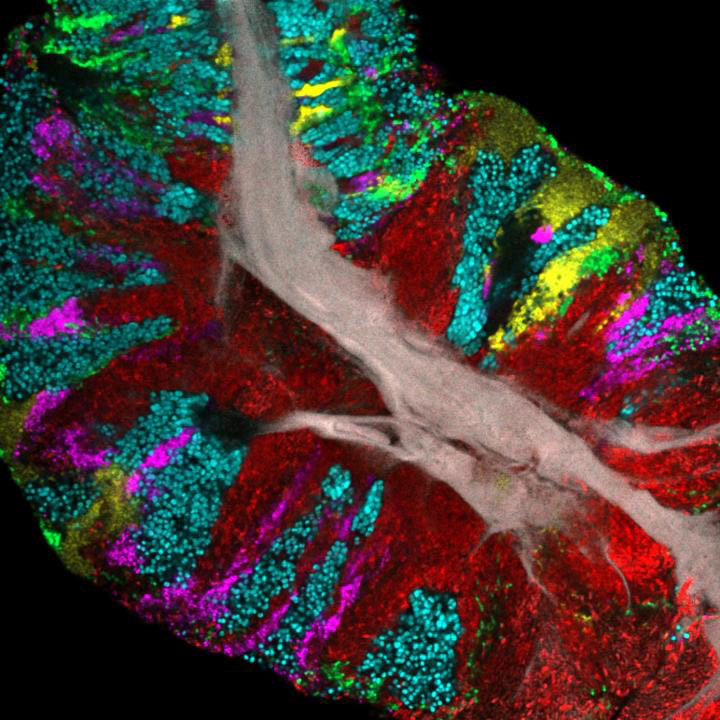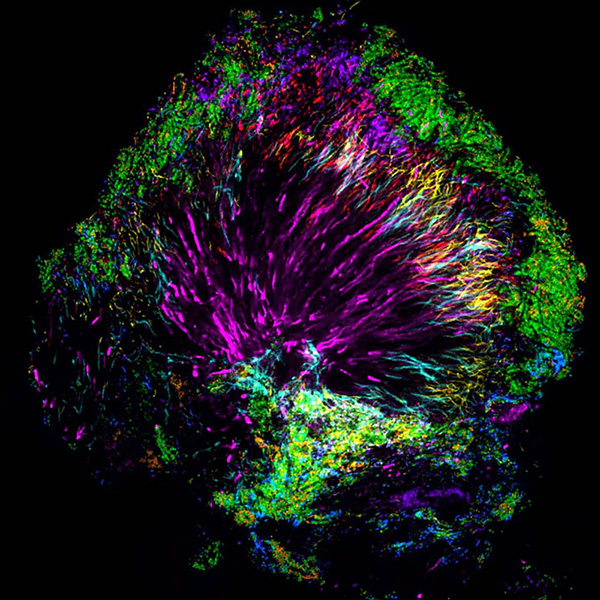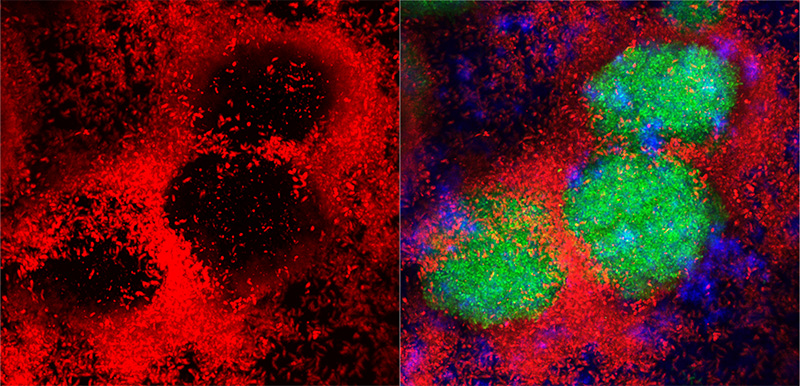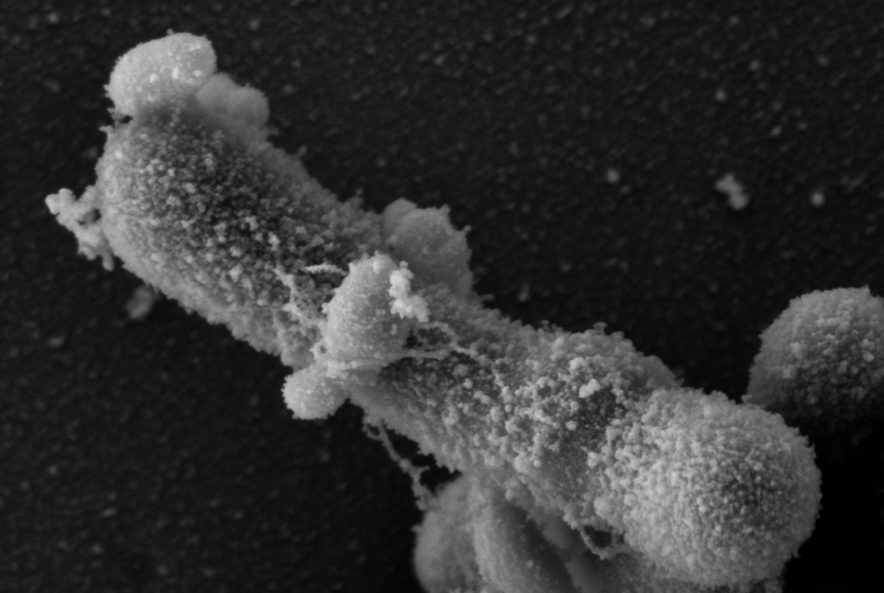Exploring the Mouth’s Microbial Wonders
Scientific expeditions into the oral cavity reveal how microbes shape health
To microbes, our mouth is an entire world unto itself — the gums, tongue, and teeth are habitats as distinct as the earth’s jungles, deserts, and Arctic. Bacteria, fungi, viruses, and other microorganisms that live in and on us — collectively known as our microbiome, or microbiota — inhabit nooks and crannies throughout the oral cavity, like animals and insects finding their homes in trees, sand dunes, and snow.
Some of these microbes cause oral diseases such as tooth decay, gum disease, lesions, and oral cancer, or are associated to systemic conditions like diabetes, dementia, and heart disease. An unhealthy microbiome can even drive formation of harmful viruses in the oral cavity. Yet most microbes promote health. They crowd out disease-causing germs to protect their turf, train the immune system to recognize harmful bugs, and spew tiny molecules that fight foes. Knowing which organisms are where, how they interact with each other, and why they behave the way they do is crucial for maintaining our oral and overall health and well-being.
For over 65 years, NIDCR-supported scientists have explored the oral cavity to understand this microbial world. In past decades, scientists at the institute demonstrated that the bacteria that cause tooth decay are transmissible and infectious and that certain bacteria cause gum disease, pushing the relationships between microbes and health into the spotlight. These early studies were the first to establish the concept of the microbiome, and they laid the groundwork for later research on the microbiome in other parts of the body. Multiple NIDCR-supported projects, including the Human Microbiome Project and the Human Oral Microbiome Database, enabled scientists to take detailed censuses of these tiny players, producing comprehensive maps of microbial communities across the body.
Today, building on decades of knowledge, oral microbiome research continues to flourish. Some NIDCR-supported scientists are investigating how microbes populate the oral landscape and, like miniscule city planners, build tiny towns. Other researchers are studying molecules that nourish health-promoting microbes and suppress disease-driving ones to identify prebiotics that could improve oral health. Scientists have studied relationships between the oral microbiome and multiple systemic diseases. Still others are exploring oral microbial “dark matter,” the microbes that scientists know exist, based on genomic studies, but cannot be grown and studied in petri dishes. These mysterious microorganisms are also sometimes called “uncultivables.”
“Because of the mouth’s accessibility, it was the first and remains one of the most-studied body sites in human microbiome research,” said NIDCR Deputy Director Jennifer Webster-Cyriaque, D.D.S., Ph.D. “The oral microbiome has provided insights into microbial ecology and host-immune responses and disease within the mouth and throughout the body. It is a crucial component of both oral and systemic health.”
Fantastic Microbes and Where to Find Them
While the microbial communities in the mouth are exposed to the same temperatures, saliva, and immune factors, they’re not just random groupings of cells and organisms. By growing bacteria in the lab and sequencing their DNA, scientists have discovered that the microbial composition of the cheek linings, roof of the mouth, and even above and below the gumline are distinct. However, these methods only reveal the general region where microbes live. It’s like knowing a zip code but not an address.
To pinpoint the exact locations of the bacteria in these microbial communities, senior scientist Jessica Mark Welch, Ph.D., and senior investigator Gary Borisy, Ph.D., of the ADA Forsyth Institute, designed a new imaging method that color-labels eight to 10 groups of bacteria at once. Peering into scrapings from dental plaque and tongues of healthy participants with this new method, the scientists were able to visualize microbial towns in rainbow hues.
In the dental plaque samples, the town center was composed of a magenta-stained bacterial species called Corynebacterium, with long filaments that anchor to teeth. Bordering these filaments, making up the outskirts of the town, were tiny green spheres of oxygen- and sugar-consuming Streptococcus. Orange Aggregatibacter often neighbored Streptococcus, feeding off the acidic molecules they produce. Below this initial layer of microbes resided carbon-dioxide-loving, oxygen-averse bacteria like Capnocytophaga and Fusobacterium, stained in red and yellow, respectively.
“These microbial structures function in much the same way that an oak tree provides a habitat for birds, squirrels, and other creatures,” said Dr. Mark Welch. “We haven’t seen any microbial organization as complex as what we see in the human mouth.”
The NIDCR-supported study, published in 2016, offered a new perspective on the oral microbiome, revealing functions and microbial relationships that couldn’t be gleaned from genomics alone. Drs. Mark Welch and Borisy continue to map other oral sites using imaging and DNA sequencing. They believe learning where bacteria live and what they do can reveal strategies to encourage growth of health-promoting bacteria in the mouth.
“This world of bacteria is just so amazing — they build bacterial high rises and microbial apartment buildings in your mouth,” said Dr. Mark Welch. “It’s been right there forever, and yet we’re only just now seeing it.”
Friend or Foe?
Residents of these oral microbial towns are deeply interconnected. In some cases, they work together to drive disease. In other cases, they compete for turf and resources. These microbial interplays can sway our health in one direction or the other.
A recent NIDCR-supported study found that the bacterium Streptococcus mutans, a major driver of tooth decay, has a partner in crime — Selenomonas sputigena. The team found that S. sputigena forms a honeycomb-like structure that encases S. mutans to increase and concentrate the production of tooth-damaging acid, which boosted tooth decay in mice. Breaking up this bacterial duo, which is linked to tooth decay in children, could be a caries prevention strategy. The study was led by Kimon Divaris, D.D.S., Ph.D., and Di Wu, Ph.D., at the University of North Carolina at Chapel Hill, and Hyun (Michel) Koo, D.D.S., Ph.D., from the University of Pennsylvania.
S. mutans can even form cross-kingdom partnerships to promote tooth decay. Dr. Koo and collaborators recently discovered that S. mutans can hitch a piggyback ride on oral fungi. In lab experiments, the bacteria and fungi formed a superorganism that “walked” and “lunged” across tooth-like surfaces by using the fungi’s fiber-like hyphae as legs. These movements allow the microbes to spread faster and farther than either organism alone, shedding light on the interplay between microbes and disease.
Recent studies from Jessica Scoffield, Ph.D., of the University of Alabama at Birmingham showed that a friendly bacterium found in healthy microbiomes called Streptococcus parasanguinis is a gatekeeper of oral health. This bacterium can help turn nitrite, a byproduct of dietary nitrate abundant in leafy greens like spinach and lettuce, into antimicrobial molecules. In 2019, Dr. Scoffield’s team showed that rats that had been colonized with S. parasanguinis and drank nitrite-laced water had less tooth decay after being infected with disease-driving S. mutans than those that did not receive nitrite.
“The presence of nitrite or nitrate reduces the ability of tooth-decay-causing pathogens to eat sugar,” said Dr. Scoffield. “The findings also highlight the importance of a healthy diet — eat your leafy green vegetables.”
More recently, her team found that nitrite aids S. parasanguinis in suppressing the growth of oral pathogens, assuring the healthy bacterium’s dominance. Nitrite triggers the bacterium to produce unique metabolic signals that kill pathogens while protecting itself, a previously unknown phenomenon.
The NIDCR-supported study suggests that nitrite might be useful as a prebiotic to foster oral health. It also opens a door to new research on how metabolic signals alter the structure and function of oral microbial communities, which may lead to potential therapeutics.
Oral Microbial “Dark Matter”
While the mouth is arguably the most well-studied microbial habitat in our body, out of the 774 known oral bacterial species, one-third are considered microbial “dark matter.” Scientists know these microbes exist because they can detect their DNA, but they struggle to grow them in labs. For this reason, these elusive bacteria are also sometimes called “uncultivables.”
Many dark matter species belong to a group of ultra-tiny bacteria called candidate phyla radiation (CPR). The family was first described in 1981 and is found almost everywhere: in soil, seawater, hot springs, termite guts, and humans. But no one had successfully isolated them, and they had remained elusive until 2015, when senior scientist Xuesong He, D.D.S., Ph.D., of the ADA Forsyth Institute, first grew a CPR bacterium called Nanosynbacter lyticus strain TM7x (TM7x for short) in the lab.
As it turns out, it was impossible to isolate and grow TM7x bacteria on their own because these nano-sized spherical cells are physically bound to their rod-shaped host, Schaalia odontolytica.
“TM7x is missing a lot of genes that allow it to exist as a free-living bacterium,” said Dr. He. “For example, they cannot produce many of the amino acids that are building blocks for life. They must suck up nutrients from the host, and that explains their reliance.”
Dr. He’s team dove into studying the relationship between TM7x and S. odontolytica. In an NIDCR-supported study, they found that although TM7x is parasitic, which hampers the growth of its host and can even kill the host, there are benefits to the relationship. TM7x protects the host from predators called phages that hunt and kill bacteria. It does this by influencing gene expression in the host, causing changes to the structure of molecules on the host’s surface, which helps prevent phages from attaching to and destroying the bacterium.
Previous research has revealed links among TM7x, gum disease, and other inflammatory diseases. However, Dr. He and his long-time collaborator Batbileg Bor, Ph.D., at ADA Forsyth Institute say the disease connection is complex. In their lab experiments, introducing the host, S. odontolytica, by itself into mice triggered gum inflammation. But colonizing mice with S. odontolytica along with TM7x caused inflammation to subside, pointing to TM7x’s potential as a health-protective organism.
“All the knowledge we’ve gained can be a roadmap to understand other uncultivable bugs,” Dr. He said. “In addition, it is estimated that over 25% of Earth's microbial species have a symbiotic lifestyle similar to TM7x.”
What the Future Holds
Today, multiple NIDCR-supported projects continue to build on the foundation of microbial knowledge gained to date, aiming to turn lab discoveries into better health and well-being. One group of researchers is identifying health-promoting oral bacteria to develop probiotics to maintain oral health. Others are exploring an innovative dental filling that can fight disease-causing bacteria through small pulses of electricity. Many more are characterizing the microbial communities that contribute to certain diseases, and more importantly, how to restore balance to the oral microbiome and shift disease to health.
“As we unravel the intricate relationships among microbes, disease, and health, we open up opportunities for innovative treatments and preventative strategies,” said Tamara McNealy, Ph.D., Director of NIDCR’s Oral Microbiota and Bacterial Disease Program. “Understanding the oral microbiome is important not just for the teeth and gums; it’s about the health of the entire body.”
Related Links
References
- Mark Welch JL, Rossetti BJ, Rieken CW, Dewhirst FE, Borisy GG. Biogeography of a human oral microbiome at the micron scale. Proc Natl Acad Sci U S A. 2016 Feb 9;113(6):E791-800. doi: 10.1073/pnas.1522149113. Epub 2016 Jan 25.
- Cho H, Ren Z, Divaris K, Roach J, Lin BM, Liu C, et al. Selenomonas sputigena acts as a pathobiont mediating spatial structure and biofilm virulence in early childhood caries. Nat Commun. 2023 May 22;14(1):2919. doi: 10.1038/s41467-023-38346-3.
- Scoffield J, Michalek S, Harber G, Eipers P, Morrow C, Wu H. Dietary Nitrite Drives Disease Outcomes in Oral Polymicrobial Infections. J Dent Res. 2019 Aug;98(9):1020-1026. doi: 10.1177/0022034519855348. Epub 2019 Jun 20.
- Huffines JT, Stoner SN, Baty JJ, Scoffield JA. Nitrite Triggers Reprogramming of the Oral Polymicrobial Metabolome by a Commensal Streptococcus. Front Cell Infect Microbiol. 2022 Mar 1;12:833339. doi: 10.3389/fcimb.2022.833339.
- He X, McLean JS, Edlund A, Yooseph S, Hall AP, Liu SY, et al. Cultivation of a human-associated TM7 phylotype reveals a reduced genome and epibiotic parasitic lifestyle. Proc Natl Acad Sci U S A. 2015 Jan 6;112(1):244-9. doi: 10.1073/pnas.1419038112.
- Zhong Q, Liao B, Liu J, Shen W, Wang J, Wei L, et al. Episymbiotic Saccharibacteria TM7x modulates the susceptibility of its host bacteria to phage infection and promotes their coexistence. Proc Natl Acad Sci U S A. 2024 Apr 16;121(16):e2319790121. doi: 10.1073/pnas.2319790121. Epub 2024 Apr 9.
Attention Editors
Reprint this article in your own publication or post to your website. NIDCR News articles are not copyrighted. Please acknowledge NIH's National Institute of Dental and Craniofacial Research as the source.
Subscribe for NIDCR Updates
Receive email updates about the latest advances in dental, oral, and craniofacial research.
October 2024




